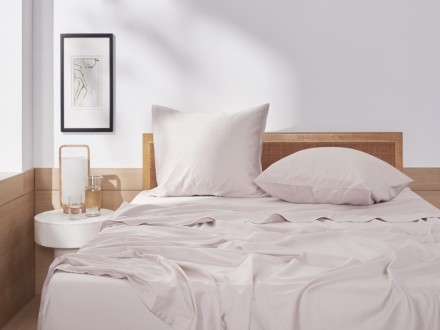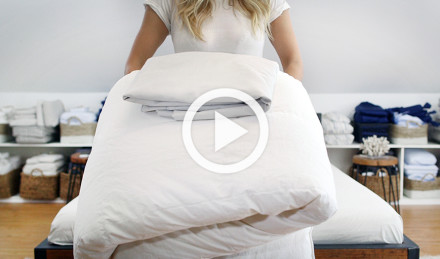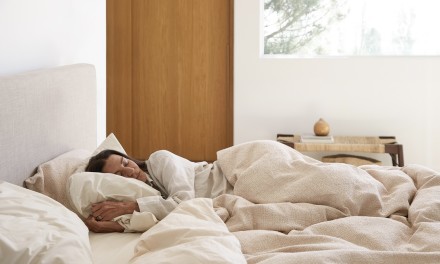Shopping for bedding can be a fun yet overwhelming activity. Aside from the creative side of shuffling through prints and colors, choosing the right bed linen material takes plenty of research and practical knowledge about fabrics and materials. You’d be forgiven if you ever saw satin or sateen on a label and thought one was the misspelled version of the other. The two are actually completely different materials that possess distinct qualities. Shoppers also often confuse satin and silk, as the two look strikingly alike.
So if you’re on the hunt for luxury bed sheets, read on for a handy breakdown of sateen vs. satin — and sateen vs. silk bedding — that will help you differentiate between the three. Ultimately, we’ll guide you to the right bedding products that fit your lifestyle.
What is Sateen?
What is Sateen?
The word “sateen” refers to a weaving technique rather than a distinct material. The sateen weave uses a pattern of one yarn under and four (or more) weft threads over. The result is a thicker, warmer, heavier sateen texture with a very subtle sheen that looks and feels luxurious.
Technically, you could manufacture “sateen” with cotton, polyester and rayon. But a blend like that will significantly influence the overall feel of the fabric (polyester, for example, tends to make you sweat). By contrast, blending with 100% premium cotton, such as egyptian cotton, produces the highest-quality sateen material because it doesn’t overheat your body and is incredibly soft to the touch.
The Pros and Cons of Sateen
Sateen weave mainly uses shorter-staple fibers such as cotton, giving the end product all the most prized qualities of the versatile fabric. Sateen bedding is strong, soft to the touch, has a lovely sheen and drapes beautifully. Because cotton sateen fabric is thicker than regular cotton, sateen bed sheets are also wrinkle-resistant.
Unfortunately, because of that thickness, some sleepers may feel like the material also traps heat. So if you’re a hot sleeper, sateen might not be the best choice for you.
Caring for sateen sheets is extremely easy. Simply wash them in cool water with a mild, non-toxic detergent and tumble dry low. Never wash sateen bedding in hot water, or dry it with hot air as this may damage the fabric.
If you’d like to read more about sateen, check out our post, Sateen: Know Your Bedding Like a Designer.
The Pros and Cons of Sateen
Sateen weave mainly uses shorter-staple fibers such as cotton, giving the end product all the most prized qualities of the versatile fabric. Sateen bedding is strong, soft to the touch, has a lovely sheen and drapes beautifully. Because cotton sateen fabric is thicker than regular cotton, sateen bed sheets are also wrinkle-resistant.
Unfortunately, because of that thickness, some sleepers may feel like the material also traps heat. So if you’re a hot sleeper, sateen might not be the best choice for you.
Caring for sateen sheets is extremely easy. Simply wash them in cool water with a mild, non-toxic detergent and tumble dry low. Never wash sateen bedding in hot water, or dry it with hot air as this may damage the fabric.
If you’d like to read more about sateen, check out our post, Sateen: Know Your Bedding Like a Designer.
What is Silk?
What is Silk?
Silk has a fascinating history. Invented in Ancient China thousands of years ago, legend has it that the fabric got its start when Empress Si Ling-Chi discovered the silkworm after a cocoon accidentally dropped into her tea. When she pulled the cocoon from her cup, a shimmering thread began to unravel. Curious, she searched until she found its source — the Bombyx mori larvae.
Today, the best quality silk material is still produced by the cocoons of the mulberry silkworm: Bombyx mori. This natural filament can reach up to 3,000 feet in length from a single cocoon and is composed of fibroin protein. Because these filaments are too thin for use in fabric on their own, several filaments are twisted together into a much stronger yarn. In fact, silk is the strongest natural fiber in the world.
The Pros and Cons of Silk
Silk is a natural material that is lightweight, extremely breathable and dries fast. Silk fabric regulates body temperature well, so it can make you feel cool in the summer and warm in the winter. This temperature-regulating feature is one major difference between sateen vs. silk bedding.
If you’re looking for a breathable, incredibly-soft fabric that works perfectly year round, then invest in silk bedding.
We say “invest” because purchasing a set of silk sheets can genuinely feel like an investment. This luxurious material comes with a similarly extravagant price tag that can be a disadvantage. Another point against silk is that it’s not the most absorbent of materials. So if you tend to sweat at night, you might end up destroying your silk bed sheets fairly quickly. And finally, while some sleepers like the luxurious sheen of silk, others find it doesn’t fit in with their bedroom aesthetic.
You can wash silk sheets at home, although greater care is needed than with traditional bedding materials like sateen or satin. Hand-wash silk bed sheets in cold water with a mild detergent specially formulated for silk. Never put silk sheets in the dryer. Fortunately, the fabric dries fast, so you can hang it indoors, but always away from direct sunlight (as sunlight can cause discoloration or damage to the material). For more insights on caring for your bedding, see our guide on How to Wash and Properly Care for Bedding.
The Pros and Cons of Silk
Silk is a natural material that is lightweight, extremely breathable and dries fast. Silk fabric regulates body temperature well, so it can make you feel cool in the summer and warm in the winter. This temperature-regulating feature is one major difference between sateen vs. silk bedding.
If you’re looking for a breathable, incredibly-soft fabric that works perfectly year round, then invest in silk bedding.
We say “invest” because purchasing a set of silk sheets can genuinely feel like an investment. This luxurious material comes with a similarly extravagant price tag that can be a disadvantage. Another point against silk is that it’s not the most absorbent of materials. So if you tend to sweat at night, you might end up destroying your silk bed sheets fairly quickly. And finally, while some sleepers like the luxurious sheen of silk, others find it doesn’t fit in with their bedroom aesthetic.
You can wash silk sheets at home, although greater care is needed than with traditional bedding materials like sateen or satin. Hand-wash silk bed sheets in cold water with a mild detergent specially formulated for silk. Never put silk sheets in the dryer. Fortunately, the fabric dries fast, so you can hang it indoors, but always away from direct sunlight (as sunlight can cause discoloration or damage to the material). For more insights on caring for your bedding, see our guide on How to Wash and Properly Care for Bedding.
What is Satin?
Is satin the same as silk? The answer is “no.” The main difference between silk and satin is that the former is a raw material, while the latter is a weaving pattern. Satin texture is characterized by a shiny, lustrous front and a duller back. It’s manufactured by floating warp yarns across the weft before passing under a single weft thread.
What is Satin?
Is satin the same as silk? The answer is “no.” The main difference between silk and satin is that the former is a raw material, while the latter is a weaving pattern. Satin texture is characterized by a shiny, lustrous front and a duller back. It’s manufactured by floating warp yarns across the weft before passing under a single weft thread.
What is Satin Made of?
Like sateen, satin material can be produced using various fibers with long filaments, such as silk, polyester, and nylon. The final product is durable and drapes beautifully, which is why it is often used in fashion products.
Having said that, a satin weave created with cotton, which is generally a short-staple yarn, is technically sateen.
What is Satin Made of?
Like sateen, satin material can be produced using various fibers with long filaments, such as silk, polyester, and nylon. The final product is durable and drapes beautifully, which is why it is often used in fashion products.
Having said that, a satin weave created with cotton, which is generally a short-staple yarn, is technically sateen.
The Pros and Cons of Satin
Satin is a long-staple material that’s both luxurious to the touch and durable, but it does have disadvantages, including reduced breathability and challenging wash and dry instructions. The satin vs sateen question has a few important details to understand.
The Pros and Cons of Satin
Satin is a long-staple material that’s both luxurious to the touch and durable, but it does have disadvantages, including reduced breathability and challenging wash and dry instructions. The satin vs sateen question has a few important details to understand.
What is the Difference Between Satin and Sateen?
Satin and sateen actually share the same weave but are made from different fibers. Satin is made from long filaments, while sateen comes from short-staple fibers. Both fabrics have that luxurious shiny look and are also wrinkle-resistant, but the similarities often end there.
Because satin is usually made from synthetic fibers for affordability, it’s not particularly breathable. When used to manufacture bedding, satin sheets can trap heat and cause you to sweat more. This heat-trapping ability makes it excellent for clothing worn for a few hours, but not as much for bed linen that you’ll sleep in for at least eight hours every night. So if you’re choosing between sateen vs. satin bedding, you might want to choose sateen.
Satin is also more challenging to care for. If your satin bed sheets are made from silk (which is rare but possible) you absolutely have to dry clean them. If they’re made from polyester or nylon, you can wash them at home on the gentle cycle or by hand in cold water. The only way to properly dry satin sheets is to lay them down on a towel to dry.
What is the Difference Between Satin and Sateen?
Satin and sateen actually share the same weave but are made from different fibers. Satin is made from long filaments, while sateen comes from short-staple fibers. Both fabrics have that luxurious shiny look and are also wrinkle-resistant, but the similarities often end there.
Because satin is usually made from synthetic fibers for affordability, it’s not particularly breathable. When used to manufacture bedding, satin sheets can trap heat and cause you to sweat more. This heat-trapping ability makes it excellent for clothing worn for a few hours, but not as much for bed linen that you’ll sleep in for at least eight hours every night. So if you’re choosing between sateen vs. satin bedding, you might want to choose sateen.
Satin is also more challenging to care for. If your satin bed sheets are made from silk (which is rare but possible) you absolutely have to dry clean them. If they’re made from polyester or nylon, you can wash them at home on the gentle cycle or by hand in cold water. The only way to properly dry satin sheets is to lay them down on a towel to dry.
The Best Silk, Sateen and Satin Bedding Products
Silk, sateen, and satin all make excellent choices for different, specific products. Sateen is the perfect bedding material for winter. It’s soft, cozy and warm. So if you’re looking to switch up your breezy summer bed linens for a thicker option more in sync with cooler months, then select a sateen bedroom bundle.
Silk, on the other hand, is a popular pillowcase fabric. The reason? The material is smooth and less likely to cause “crush wrinkles” on your skin or absorb moisture from your skin the way cotton does. Another benefit to sleeping on a silk pillowcase is that every day will be a “good hair day.” Again, the main reason for that is silk’s smooth texture that prevents frizz.
Of course, silk can be pretty pricey. So if you’re wondering whether to go with a satin vs silk pillowcase, silk may be of higher quality, but satin is less expensive. Generally, the satin fabric is used for clothing and upholstery, although satin sheeting is a popular product category, too. Keep quality and price in mind when you decide whether a silk or satin pillowcase is best for you. And be sure to check out our Pillowcase & Sham Guide for additional tips.
The Best Silk, Sateen and Satin Bedding Products
Silk, sateen, and satin all make excellent choices for different, specific products. Sateen is the perfect bedding material for winter. It’s soft, cozy and warm. So if you’re looking to switch up your breezy summer bed linens for a thicker option more in sync with cooler months, then select a sateen bedroom bundle.
Silk, on the other hand, is a popular pillowcase fabric. The reason? The material is smooth and less likely to cause “crush wrinkles” on your skin or absorb moisture from your skin the way cotton does. Another benefit to sleeping on a silk pillowcase is that every day will be a “good hair day.” Again, the main reason for that is silk’s smooth texture that prevents frizz.
Of course, silk can be pretty pricey. So if you’re wondering whether to go with a satin vs silk pillowcase, silk may be of higher quality, but satin is less expensive. Generally, the satin fabric is used for clothing and upholstery, although satin sheeting is a popular product category, too. Keep quality and price in mind when you decide whether a silk or satin pillowcase is best for you. And be sure to check out our Pillowcase & Sham Guide for additional tips.
Where to Shop for Quality Bedding?
If you’re in the market for a new bedding set, check out Parachute’s excellent sateen options. We only use 100% premium, certified long-staple Egyptian cotton, creating an extra-strong, soft and shiny sateen fabric. Sateen has a distinctly luxurious look that will instantly transform your bedroom into a five-star sanctuary. You can choose between separates such as fitted sheets, sateen top sheets, duvet covers and soft sateen pillowcases. Or you can choose a sateen double up bundle that has everything you need to make your bed.
And to get your best beauty rest yet — and have your skin and hair look like it — shop for Parachute’s pure silk pillowcase, made from luxurious Mulberry silk and available in white and light grey.
If you’d like to find out more about the different bedding materials you’ll find at Parachute, read our Fabric & Bedding Materials Guide.
Where to Shop for Quality Bedding?
If you’re in the market for a new bedding set, check out Parachute’s excellent sateen options. We only use 100% premium, certified long-staple Egyptian cotton, creating an extra-strong, soft and shiny sateen fabric. Sateen has a distinctly luxurious look that will instantly transform your bedroom into a five-star sanctuary. You can choose between separates such as fitted sheets, sateen top sheets, duvet covers and soft sateen pillowcases. Or you can choose a sateen double up bundle that has everything you need to make your bed.
And to get your best beauty rest yet — and have your skin and hair look like it — shop for Parachute’s pure silk pillowcase, made from luxurious Mulberry silk and available in white and light grey.
If you’d like to find out more about the different bedding materials you’ll find at Parachute, read our Fabric & Bedding Materials Guide.







